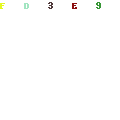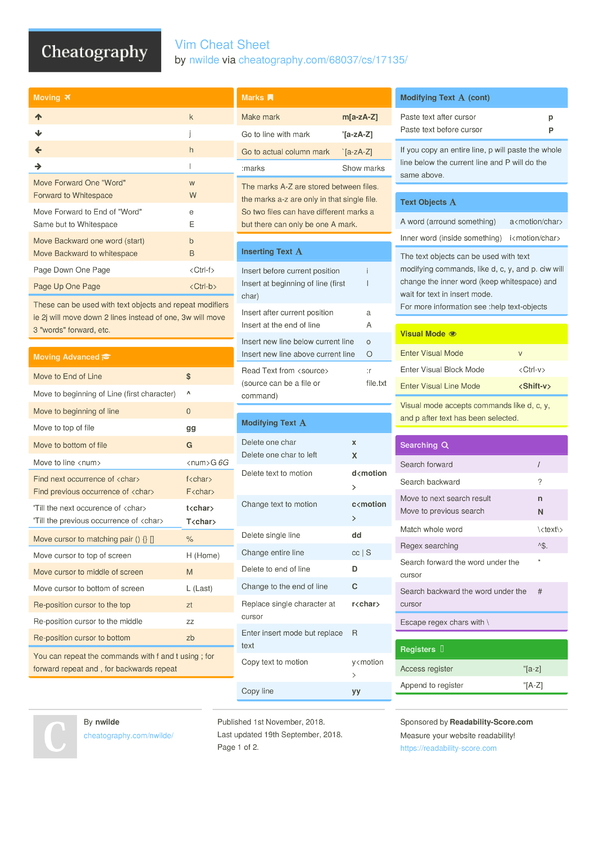Vim cheat sheet Allison McKnight (aemcknig@andrew.cmu.edu) Navigation h Move left H Top line on screen j Move down M Middle line on screen k Move up L Bottom line on screen l Move right 10j Move down 10 lines gg First line of the le e The end of the current word. A Great Vim Cheat Sheet. I’ve compiled a list of essential Vim commands that I use every day. I have then given a few instructions on how to make Vim as great as it should be, because it’s painful without configuration. Essentials Cursor movement (Normal/Visual Mode) h j k l - Arrow keys. About the vim cheat sheet. This project aims to be one of the most accessible vim guides available. We made sure to support mobile, desktop, and other languages. ️ Please consider sponsoring this project ️! A Great Vim Cheat Sheet. Vim-sensible: tiny set of reasonable defaults that every vim user should have. This allows you to keep your.vimrc a bit smaller.
I’ve compiled a list of essential Vim commands that I use every day. I have then given a few instructions on how to make Vim as great as it should be, because it’s painful without configuration.
Essentials
Cursor movement (Normal/Visual Mode)
hjkl- Arrow keysw/b- Next/previous wordW/B- Next/previous word (space seperated)e/ge- Next/previous end of word0/$- Start/End of line^- First non-blank character of line (same as0w)
Editing text
i/a- Start insert mode at/after cursorI/A- Start insert mode at the beginning/end of the lineo/O- Add blank line below/above current lineEscorCtrl+[- Exit insert moded- Deletedd- Delete linec- Delete, then start insert modecc- Delete line, then start insert mode
Operators
- Operators also work in Visual Mode
d- Deletes from the cursor to the movement locationc- Deletes from the cursor to the movement location, then starts insert modey- Copy from the cursor to the movement location>- Indent one level<- Unindent one level- You can also combine operators with motions. Ex:
d$deletes from the cursor to the end of the line.
Marking text (visual mode)
v- Start visual modeV- Start linewise visual modeCtrl+v- Start visual block modeEscorCtrl+[- Exit visual mode
Clipboard
yy- Yank (copy) a linep- Paste after cursorP- Paste before cursordd- Delete (cut) a linex- Delete (cut) current characterX- Delete (cut) previous characterd/c- By default, these copy the deleted text
Exiting
:w- Write (save) the file, but don’t quit:wq- Write (save) and quit:q- Quit (fails if anything has changed):q!- Quit and throw away changes
Search/Replace
/pattern- Search for pattern?pattern- Search backward for patternn- Repeat search in same directionN- Repeat search in opposite direction:%s/old/new/g- Replace all old with new throughout file (gn is better though):%s/old/new/gc- Replace all old with new throughout file with confirmations
General
u- UndoCtrl+r- Redo

Advanced
Cursor movement
Ctrl+d- Move down half a pageCtrl+u- Move up half a page}- Go forward by paragraph (the next blank line){- Go backward by paragraph (the next blank line)gg- Go to the top of the pageG- Go the bottom of the page: [num] [enter]- Go to that line in the documentctrl+e / ctrl+y- Scroll down/up one line
Character search
f [char]- Move forward to the given charF [char]- Move backward to the given chart [char]- Move forward to before the given charT [char]- Move backward to before the given char;/,- Repeat search forwards/backwards
Editing text
J- Join line below to the current oner [char]- Replace a single character with the specified char (does not use Insert mode)
Visual mode
O- Move to other corner of blocko- Move to other end of marked area
File Tabs
:e filename- Edit a file:tabe- Make a new tabgt- Go to the next tabgT- Go to the previous tab:vsp- Vertically split windowsctrl+ws- Split windows horizontallyctrl+wv- Split windows verticallyctrl+ww- Switch between windowsctrl+wq- Quit a window
Marks
- Marks allow you to jump to designated points in your code.
m{a-z}- Set mark {a-z} at cursor position- A capital mark {A-Z} sets a global mark and will work between files
'{a-z}- Move the cursor to the start of the line where the mark was set'- Go back to the previous jump location
Text Objects
- Say you have
def (arg1, arg2, arg3), where your cursor is somewhere in the middle of the parenthesis. di(deletes everything between the parenthesis. That says “change everything inside the nearest parenthesis”. Without text objects, you would need to doT(dt).
General
.- Repeat last commandCtrl+r + 0in insert mode inserts the last yanked text (or in command mode)gv- reselect (select last selected block of text, from visual mode)%- jumps between matching()or{}

Vim is quite unpleasant out of the box. It’s an arcane experience:
- Autocomplete is missing
- System clipboard is not used
- Act of typing
:wto save is cumbersome - Mouse doesn’t work
- Management of multiple files is tricky
- Ability to indent multiple lines is missing
It does have a significant strength though: your fingers can stay on the main keyboard keys to do most editing actions. This is faster and more ergonomic. I find that the toughest part about VIM is guiding people towards getting the benefits of VIM without the drawbacks. Here are two ideas on how to go about this.
Switch caps lock and escape


- I highly recommend you switch the mapping of your caps lock and escape keys. You’ll love it, promise! Switching the two keys is platform dependent.
Visual Studio Code
- VSCode is the simplest way to give you a fantastic editor that also gives you the benefits of VIM. Just install the VIM extension.
- I made a few slight changes which improved the experience for me.

Configure native VIM
For all the given limitations, you’ll need to find a solution. You can either solve the issues one by one, or you can use a reference .vimrc settings file that fix most of the issues out-of-the-box.
- My .vimrc file could be a good starting point. Honestly, it’s a bit old and not the best. I now use VSCode mainly so I haven’t kept a great vimrc.
Using the system clipboard
'+ycopy a selection to the system clipboard'+ppaste from the system clipboard- If this doesn’t work, it’s probably because Vim was not built with the system clipboard option. To check, run
vim --versionand see if+clipboardexists. If it says-clipboard, you will not be able to copy from outside of Vim.- For Mac users, homebrew install Vim with the clipboard option. Install homebrew and then run
brew install vim.- then move the old Vim binary:
$ mv /usr/bin/vim /usr/bin/vimold - restart your terminal and you should see
vim --versionnow with+clipboard
- then move the old Vim binary:
- For Mac users, homebrew install Vim with the clipboard option. Install homebrew and then run
Sublime Text
- Another option is to use Vintageous in Sublime Text (version 3). This gives you Vim mode inside Sublime. I suggest this (or a similar setup with the Atom editor) if you aren’t a Vim master. Check out Advanced Vim if you are.
- Vintageous is great, but I suggest you change a few settings to make it better.
- Clone this repository to
~/.config/sublime-text-3/Packages/Vintageous, or similar. Then check out the “custom” branch.- Alternatively, you can get a more updated Vintageous version by cloning the official repository and then copying over this patch.
- Change the user settings (
User/Preferences.sublime-settings) to include:'caret_style': 'solid'- This will make the cursor not blink, like in Vim.
- Sublime Text might freeze when you do this. It’s a bug; just restart Sublime Text after changing the file.
ctrl+rin Vim means “redo”. But there is a handy Ctrl + R shortcut in Sublime Text that gives an “outline” of a file. I remapped it to alt+r by putting this in the User keymap{ 'keys': ['alt+r'], 'command': 'show_overlay', 'args': {'overlay': 'goto', 'text': '@'} },
- Mac users: you will not have the ability to hold down a navigation key (like holding j to go down). To fix this, run the commands specified here: https://gist.github.com/kconragan/2510186
- Clone this repository to
- Now you should be able to restart sublime and have a great Vim environment! Sweet Dude.
Other
I don’t personally use these yet, but I’ve heard other people do!
:wqa- Write and quit all open tabs (thanks Brian Zick)
Vim Cheat Sheet 1440
Additional resources
- Practical Vim is a fantastic resource on many of the useful hidden features of vim.
Vim is a powerful text editor,it ships with every unix-like operating system. It is a editor to which if you get addicted you can’t go back. Here’s a cheat sheet I prepared for you guys.
Vim Cheat Sheet Pdf
Note! -<x> - Means imaginary number<c> - Means - imaginary character
Modes in VIM - K mac new rap mp3 free download.
Normal Mode- To run commands and move through h,j,k,l keys in the documentInsert Mode - To type on the documentVisual Mode - To select text inside the document
Commands in Vim::q - Quits:wq - Saves & quits:q! - Quits without savingi or a - Insert ModeShift + i - Insert mode with ignoring white spacesv - For Visual ModeGG - Go to first character of documentShift+G - Go to last character of documentO - Go to first character of the line<x>G - Go to Line number<x>l - Go characters up<x>k - Go characters right<x>h - Go characters left<x>j - Go characters down x - Deletes a character<x>x - deletes characters<x>d - Delete Lineu - Undo <x>u - Undo timesCtrl + r - Redodw - Delete a whole worddd - Deletes a whole lined$ - Deletes whole line from cursor to the endw - Go to beginning character of wordW - Moves to word & ignores special charactersb - Moves to preceding wordB - Moves to preceding word & ignores special characterse - Moves to last character of wordE - Moves to last character of word & ignores special charactersA - Takes to last character of line & appends<x> - Takes to character of line<x>w - Go to beginning character of word<x>+shift+g+p - Moves a line to numberr - replace a characterC - Deletes whole line from cursor to the end & takes in insert modecw - Deletes a word and takes in the insert modec$ - Deletes the whole line from the cursor to end & takes in insert modejk - Moves by logical linegj - Moves by visual linef<c> - Moves forward to characterF<c> - Moves backward to charactert<c> - Moves forward to preceding / until character to character T<c> - Moves backward to preceding character to character s - deletes a characterS - deletes entire lineO - takes us to next line & insertyw - Copy’s the next wordyy - Copy’s the whole liney$ - Copy’s whole line from cursor to the endp - to paste% - To highlight open & close parentheses /<c> - To search instance forward in the document?<c> - To search instance backwards in the documentN - Takes us to the next instance of the searchCtrl + O - Takes us back to the instance that you were beforeCtrl + i - Takes us next to the instance that we’re before:%/s/<c>/<c2>/g - Replace with in the document<x>,<.x..>s/<c>/<c2>/g - Replace with in the lines<x>,<.x..>s/<c>/<c2>/gc - Replace with in the lines & ask every time:!<command> - Runs in terminal in vim:term - Launch terminal inside vim
That's it for today, soon to be bringing a post on vim customization. Hp laserjet p2035n driver mac download.
